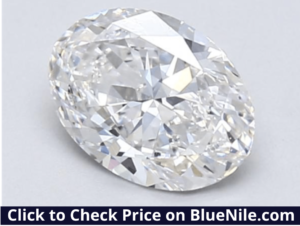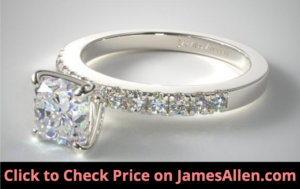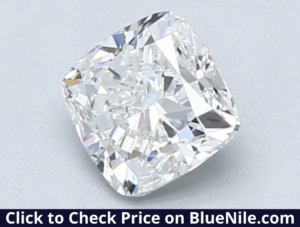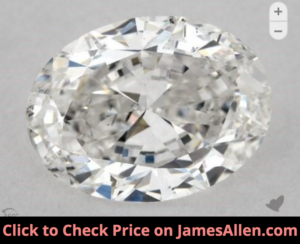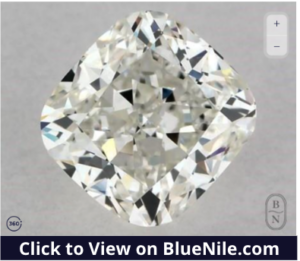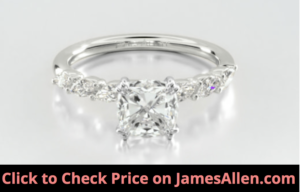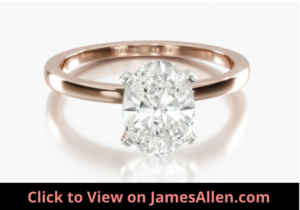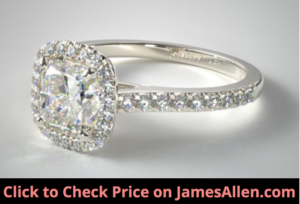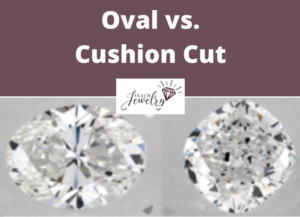
When you’re selecting a diamond ring, cut is one of the most important aspects to consider.
Oval and cushion cut diamonds are two common choices for engagement rings. You should know the differences between the two if you’ve narrowed your choice to these diamonds.
The main difference between oval and cushion cut diamonds is oval cuts have rounded edges all the way around, while cushion cuts have straight edges on each side. This creates a pillow-like shape for cushion cuts. Both are brilliant cut diamonds, so you can expect strong light performance.
We’ll compare oval versus cushion diamonds across clarity, color, price, size, and more.
What is an Oval Cut Diamond?
Oval cut diamonds are distinguished by their rounded edges and stretched table, where the center is wider than its ends.
It’s a combination of a round and pear cut diamond, except neither side has a pointed end like on a pear cut.
Check out this example in high-resolution.
These diamonds are sold in a variety of length to width ratios, but the ideal ratio is between 1.35-1.5. It’s not stretched too thin or condensed, where too much of its weight hides below the table.
Oval cuts were designed by a Russian diamond cutter named Lazare Kaplan in the mid-1900s. He cut away pieces of a damaged rough gemstone to create smaller diamonds, and one of the designs turned into the modern oval cut.
What is a Cushion Cut Diamond?
Cushion cut diamonds have rounded corners with straight edges. Most have a slightly rectangular shape, but they come in a range of length to width ratios.
Some variations appear square to the naked eye, even if the four sides aren’t the same length.
The cut was invented about 200 years ago and today is known as an “old mine cut.”
There are multiple types of cushions cut diamonds:
- Old mine
- Brilliant cut
- Modified “crushed ice”
- Modified “hybrid”
To the naked eye, each appears similar, but the differences are in the way the facets are cut. For example, old mine cuts have a deep pavilion, large culet, and high crown. The crushed ice aesthetic is formed by small star facets.
Each offers an alternative to a traditional round cut for engagement rings.
What are the Differences Between Oval and Cushion Cuts?
1. Light Performance
Oval cuts have stronger light performance compared to cushion cuts, but the difference is rarely noticeable to the naked eye.
The light performance of a diamond refers to how its brilliance and fire form scintillation. Brilliance is the white light that radiates from a diamond, and fire is colored flashes.
Together, this scintillation is a coveted trait for engagement rings, which is why the brilliant cut facets in oval and cushion cuts pass this test.
Brilliant cut facets are generally small and triangular in shape, which allows them to capture light, bounce it around inside the gem, and send it back to the viewer.
A minimal amount is lost through the culet, so more is returned to the eye.
An oval cut that’s stretched thin may have diminished light performance. In that case, the condensed facets of a cushion cut could outshine it.
2. Hiding Inclusions
A diamond’s clarity is based on the presence of inclusions, of flaws, within its facets. They develop during its formation and can take the form of:
- Twinning wisps
- Cavities
- Etch channels
- Pinpoints
Inclusions affect its appearance, brilliance, and durability, so most buyers aim to minimize the size and number of blemishes without paying the premium charged for a flawless or VVS clarity diamond.
Some cuts hide inclusions more than others because of their light performance.
That means oval cuts often appear cleaner than cushion cuts, even if they have the same clarity grade.
Your goal should be to find an eye-clean diamond, so inclusions are only visible with magnification. For oval diamonds under 1.5 carats, you can start your search at SI1, but always view the diamond in-person or through high-quality images to search for inclusions.
For example, this oval cut diamond from James Allen earned an SI1 clarity grade, but the inclusions aren’t visible to the naked eye.
You can also start with SI1 cushion cut diamonds, but you may have to move up the clarity scale to VS2 in order to find one that’s eye-clean.
As an example, this 1.01-carat cushion cut also received an SI1 clarity grade from the Gemological Institute of America, but there are black spots scattered across its table.
They’re visible in the high-resolution images and may be noticeable when viewed in person.
The way oval cuts disguise inclusions mean you can save money on your diamond by choosing one with a lower clarity that still achieves the same effect as other cuts with a higher grade.
3. Color
The same idea is true for color. Diamonds with strong brilliance hide the yellow or brown tints that are present in ones graded lower on the GIA color scale.
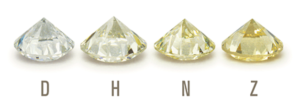
Colorless diamonds are more valuable than ones with color, but you don’t have to choose one that earned a F, E, or D color grade.
Instead, ones with lower grades can still appear colorless because the brilliant cut facets don’t show color as easily as step-cuts.
Even though oval and cushion cuts are both brilliant cuts, oval diamonds tend to hide color more effectively than cushion cuts, though it’s only a slight difference.
This 0.80-carat oval diamond earned an I color grade. To the naked eye, it likely shows no color.
But this 0.91-carat cushion cut also received an I color grade, and some of its edges have a mild yellow tint.
It’s noticeable with high-resolution photos, but may still be invisible without magnification.
If you’re considering a larger cushion or oval cut, you’ll likely have to move up the color scale to achieve the same effect.
If it’s more than 1.5 carats, the color is noticeable for many that earn an I color grade.
4. Size
The size of a diamond generally isn’t referring to its length, width, or depth. Instead, it’s measured in a unit of weight called a carat, which equals 0.2 grams.
So a cushion and oval cut that both weigh one carat are considered the same size.
But to the naked eye, some cuts look larger than others based on its proportions.
Another benefit of oval cuts is they often look bigger than cushion cuts, even if they’re the same carat weight. This is because that weight is spread across a wide table.
Cushion cuts are more condensed and may have a deeper table that hides weight below it.
These distinctions depend on their exact length to width ratio and proportions, so some cushion cuts that weigh the same as an oval cut could look larger.
5. Price
The price of a diamond is determined by a number of factors, including its grade across the four Cs of color, cut quality, clarity, and carat. The cost also differs depending on its cut.
Oval cuts are often more expensive than cushion cuts. This is one of the pros of cushion cuts.
To demonstrate this, we assessed prices for cushion and oval cuts at James Allen, an online diamond retailer, that have the following traits:
- Carat weight: 1.00
- Cut: Very good
- Color: H
- Clarity: VS2
For a cushion cut, the average price was $3,953, with a range of $3,430-$4,530.
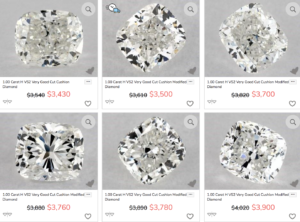
The wide range is a result of specific qualities, like the types of inclusions, its table and depth percentage, and degree of fluorescence.
The oval cuts were priced at an average of $5,086, and the range was $4,170-$6,060.
This means the oval cuts command a 29 percent premium versus cushion cuts.
Blue Nile also compiled prices for diamonds with different cuts and found a 12 percent higher cost for their oval cuts versus cushion cuts.
This demonstrates how you’ll generally pay a higher price for an oval cut, but the exact difference depends on several factors.
You can put that savings toward a higher carat weight, color or clarity grade, or setting.
6. Popularity
Some diamond cuts are more popular for engagement rings than others. The reasons vary, but buyers often want the strongest brilliance.
Cushion cuts are more popular than oval cuts.
They’re often the third or fourth most common shape for engagement rings behind round, princess, and marquise cuts. They make up about five percent of diamond sales.
Oval cuts rank sixth, usually between emerald and radiant cuts.
Both rank ahead of most step-cuts because they exhibit stronger light performance.
Neither oval nor cushion cuts are often used as accents to complement the main diamond.
Instead, round, princess, and baguette diamonds are a popular style to add more sparkle to a ring without the price increase that results from a heavier center diamond.
So if you’ve chosen a cushion or oval cut as the center diamond, you can still incorporate other shapes into your jewelry.
7. Settings
Although many buyers focus their time on finding the right diamond, you shouldn’t ignore the impact of choosing the perfect setting to hold the center stone.
Oval cuts fit a variety of settings, but the most common are four- and six-prong settings that maximize its display. The prongs don’t cover its table, so it can capture and reflect the most light.
This oval cut diamond is placed in a four-prong setting.
The prongs grasp the two ends, leaving its table exposed.
Bezel settings are also a popular choice for oval cuts because the ring of metal matches the rounded shape of the diamond.
It offers the most protection from hits and drops because the entire outer edge of the diamond is covered. The downside is it minimizes brilliance because less of the diamond is exposed.
One exceptional type of setting for cushion cuts is a halo setting. Halos are a ring of small diamonds that wrap around the main one to give the illusion of a larger stone.
It also adds brilliance.
This one-carat cushion cut engagement ring features a halo setting with pave diamonds lining the shank.
The 38 round-cut diamonds surrounding the cushion cut and cascading down the band are eye-clean and appear colorless, so the entire ring looks flawless.
Pair oval and cushion cuts with multiple types of settings to learn which combination is right for you.
8. Durability
Chips and cracks in a diamond are difficult to repair or disguise, so you should also consider its durability. Oval and cushion cuts are both durable because they lack sharp corners.
The corners on diamonds like baguette and princess cuts leave them vulnerable if hit or dropped because they’re some of the weakest points.
For example, check out this image of a princess cut, and zoom in on its sharp corners.
Its obvious they’re more susceptible than rounded edges.
Additionally, extremely thin girdles are susceptible to breaking, especially if there are large inclusions nearby.
The best way to ensure the durability of cushion and oval cuts is to place them in a secure setting.
Four-prong settings are common because they leave the most amount of the diamond exposed, but it’s one of the weaker forms of protection.
Six-prong settings provide slightly more protection, but a bezel setting is the strongest.
You should also remove the ring during physical activity or times when it’s vulnerable to catch on furniture or everyday items.
By taking these proactive steps, you can avoid durability issues.
Should You Choose an Oval or Cushion Cut?
Oval and cushion cut diamonds are alternatives to traditional round cuts that still rival its fire and brilliance.
They have many traits in common, like their brilliant-cut facets and ability to hide inclusions, but also have unique traits like their overall shape and number of facets.
If you’re comparing oval versus cushion cuts, here are guidelines to help you decide.
You should consider an oval cut diamond if:
- You’re looking for a less expensive brilliant cut than a round diamond
- You want the diamond to appear larger to the naked eye than other cuts
- Durability is an important characteristic, and you want to avoid sharp corners
You should opt for a cushion cut if:
- You want a brilliant cut diamond with a low cost-per-carat
- You’re interested in exploring the many types of cushion cuts
- You’re considering a variety of settings, and want a diamond that pairs well with all of them
Check out cushion and oval cuts at in-person and online retailers.
By pairing oval and cushion cuts with a variety of settings, you’ll find the perfect diamond ring.

Jacob Clarke
Jacob Clarke is the founder of TeachJewelry.com.
He earned an Applied Jewelry Professional Diploma from the Gemological Institute of America (GIA) and now brings you essential information about diamonds, settings, and more.
Jacob has consulted with leading jewelry brands, and his work has been cited in Clean Origin, Diamond Nexus and industry publications.
He's also a member of the International Gem Society.
He enjoys discussing jewelry with readers, so contact him with any questions at jacob.clarke@teachjewelry.com.

